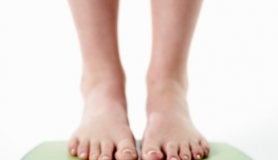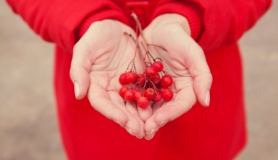1 Organic Food
Choose organic food for babies and toddlers. It is not just what organic food does contain, it is also what it does not that is important. Many additives are now being linked to health and behavioural problems, including monosodium glutamate and aspartame. These are banned under organic standards. Choosing organic food is kinder to the environment too. Organic farming works with nature, not against it, and research shows that it’s better for birds, butterflies and other wildlife. Farm animals are reared humanely and not routinely fed antibiotics to suppress disease or promote growth. If you do choose non-organic food, make sure it’s GMfree. Although convenient, processed commercial baby foods lack the enzymes and many other nutrients found in fresh foods. Organic processed foods are preferable to nonorganic ones but they are still made in factories and they shouldn’t replace homemade foods, just use occasionally as a back-up or handy supplement.
2 Organic Clothes
Unfortunately most of our clothing now contains unwanted additives that can add to our overall chemical load, causing or aggravating conditions such as asthma or eczema. The natural cotton and woollen fibres found in organic clothing are best for your baby’s skin. They have not been grown or treated with pesticides or artificial fertilizers. Other chemicals found in conventional fabric include chlorine bleach, dyes, flame retardants and stain repellents. Natural fibres, on the other hand, allow the skin to breathe and they naturally absorb moisture. Conventional cotton farming is responsible for a quarter of global pesticide sales – it is one of the most heavily sprayed crops, harming farmers and their families in the developing world. If you can afford just a few items of organic clothing, choose those closer to the skin, such as babygrows and vests.
RESOURCES
Emporium for organic clothing for babies and children from wool jumpers to organic basics – cambridgebaby.co.uk
Everyday essentials at naturebaby.com
Formerly known as Organics For Kids, we love the new prints – pigeonorganics.com
Soft, cosy merino wool clothing for babies and toddlers – engel-natur.de
Sleepwear and clothing in merino and silk – lanabambini.co.uk
3 Organic Nappies
There have been studies which link sodium polyacrylate, the gel like substance used in disposable nappies, to asthma, allergies, nappy rash, toxic shock syndrome and infertility issues in males. The studies also found dioxin, which is a byproduct of the chlorine bleaching process used in the paper in disposable nappies, to be a highly toxic carcinogen and endocrine disruptor. Thankfully you can choose organic brands that contain no harmful residues; an important consideration when the fabric is next to your baby’s skin. Use organic laundry liquid to wash the nappies. Remember that if washing nappies seems a bit overwhelming, there are laundry services that will come and take away your dirties and bring you a pile of fresh clean nappies in return.
RESOURCES
Cloth baby wipes – cheekywipes.com
Wide range of products at sarah-jaynes.com
4 The Best Organic Bedding
Many materials are treated with flame retardant or moth proofing chemicals. Formaldehyde is also used in mattress production along with solvents and foams. A baby spends between 10 – 14 hours a day asleep. In this day and age of chemical living, it is so important to limit baby’s exposure to toxic chemicals. Non-organic cotton sheets are often treated with formaldehyde. Nonorganic crib mattresses and non-natural crib mattresses contain polyurethane foam as well as phosphorus, arsenic, and antimony compounds as preservatives and fire retardants. Choose organic sheets, blankets, and mattresses to ensure your baby is not exposed to these chemicals and they are getting the best chance of quality sleep.
RESOURCES
Sleepwear and more at bambinomerino.com
Everything you need for the early years from mamanatural.co.uk
5 Organic Babycare Products
There are numerous baby skin care products out there on the market – baby wipes, ointments, lotions, creams, powders, oils, soaps and sunscreens. The cosmetic industry is unregulated, therefore many baby skin care products contain chemicals that might affect your baby’s health. The long list of ingredients which are chemicals include petroleum byproducts, preservatives, parabens, formaldehyde, dioxane and phthalates. Laurel sulfate, an irritant, which can affect a baby’s immune system, is used to create a foamy consistency and is found in most shampoos or liquid soaps. One of the most problematic ingredients is fragrance, which can cause allergic reactions, including asthma attacks.
RESOURCES
Natural products made with shea butter for baby’s and mum’s skin – sheamooti.com
Natural skincare for babies and mums – littleherbs.co.uk
Beautiful luxury items for mother and baby – rosewaterbaby.co.uk
Range of organic basics – organii.co.uk
6 Creating An Organic Nursery from Paints To Carpets
Look for paints that have low or no VOCs. The safest paints are water based made from substances like clay, citrus, talcum, balm or chalk. Organic paints are almost odourless, do not emit gasses and are very low in VOCs. If you decide that you would rather decorate the walls in the nursery with wallpaper instead of paint, be sure to pick an organic wall covering as opposed to a conventional one. Conventional wall coverings can contain toxic glue and chemicals. Invest in wood furniture constructed from FSC (Forest Stewardship Council) certified wood. If buying used furniture, buy sturdy, safe wood furniture, refinish with non-toxic paints or reupholster with organic fabric.
RESOURCES
Allergy free paint – safe for a nursery or family bedroom smldecorativepaints.co.uk
Non-toxic, odourless paints – lakelandpaints.com
Great colour ranges available from this natural VOC-free paint company – mikewye.co.uk
Clay based emulsion paints available in wide colour palate at celticsustainables.co.uk
7 Pick of the Best Organic Toys
When shopping for toys and accessories for your baby, pay attention to the materials and how they are made. Things to keep in mind are material toxicity and how easy they are to clean. If you buy plastic toys, look for ones that are free from PVC. PVC has been linked to cancer and other health problems. All plastics pose some potential risks, so it might be good to limit the number of them. Check to make sure what materials are used to make cuddly toys – both inside and out. Many baby toys have electronics embedded in them, which can increase your baby’s exposure to EMFs and may contain toxic metals or PVC.
RESOURCES
Steiner Waldorf inspired playthings for babies and children – myriadonline.co.uk
Fairtrade eco store with lovely collection of playthings – spiralsfairtrade.co.uk
Beautiful toys and craft materials – consciouscraft.uk
Gorgeous colourful selection of baby and toddler toys made from plant plastics – toyella.com
Fairtrade toys and gifts made from sustainable rubber wood – lankakade.co.uk
8 The Importance of Breastfeeding
Breastmilk is the one food perfectly designed for your baby’s health. Breastfed babies have been shown to have higher IQs than bottlefed babies due to the essential fatty acids and other nutrients available to them in breastmilk. Ideally babies should be fed on demand up to at least six months, to one year old and longer if possible. If the mother is eating a well balanced organic diet, with plenty of foods rich in fatty acids and is avoiding major stressors in her life then the quality of her milk will be extremely high, and likely free from most environmental pollutants. Breastfeeding is also convenient – you can feed your child anywhere, any time she needs it. There is little need for extra equipment but if you would like to treat yourself to a breastfeeding top or have a need for a pump with which to express milk there’s plenty of choice.
RESOURCES
Nipple butter and Milkmaid tea as well as natural bodycare products from this organic company earthmamaangelbaby.com
Range of natural, ethical products for new mums – nealsyardremedies.com
Caffeine-free organic tea for breastfeeding mums – ticktocktea.com
9 Organic Baby Gear
Using a sling or baby carrier can make moving around with a young baby much easier – you’re hands free and it’s comforting and warm for your child to be carried next to your heart. Many slings even allow for breastfeeding.
RESOURCES
Gorgeous designer carriers – madamejordan.com
Woven baby wraps handmade in England – firespiralslings.co.uk
A wide range of comfortable baby slings from well-loved brands – carrymybaby.co.uk
Colourful, beautifully designed carriers with character – sleepynico.com
Popular comfortable baby carriers – connectababycarrier.com
Beautifully designed woven slings – oschaslings.com
High quality woven wraps and carriers – storchenwiege.co.uk







